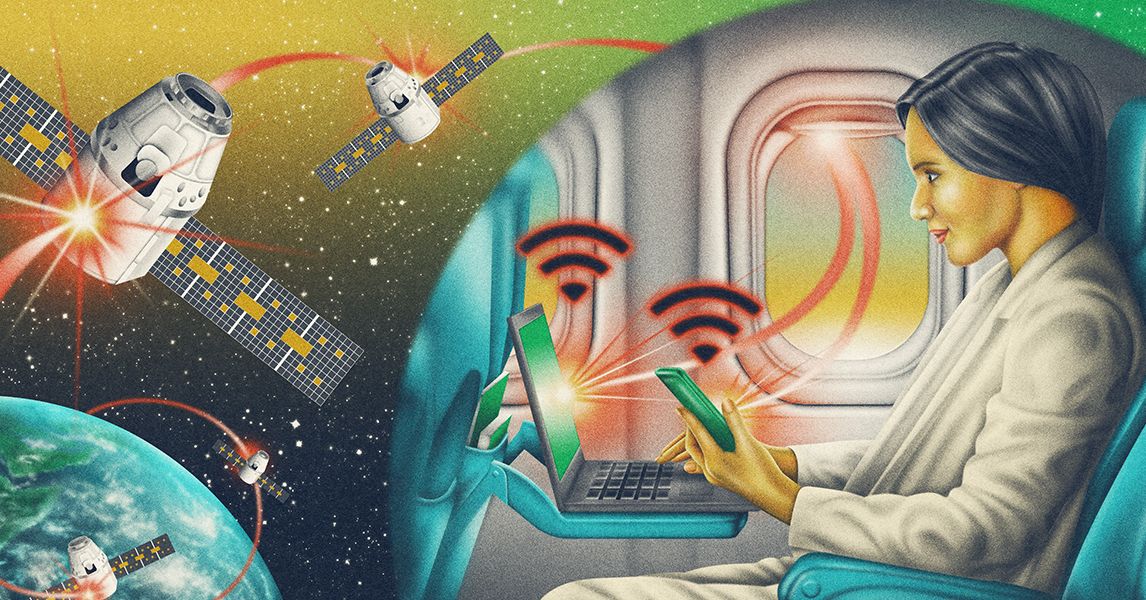Expensive and erratic,in-flightWi-Fihas been more of a punchline than a pipeline over the past decade. But 2025 has marked a sea change for the skies: the rollout of fast, and free, connectivity on most of the world’s major airlines.
Satellite technology has enabled leaps in speed and bandwidth.SpaceX’s Starlink network of low Earth orbit satellites, for example, can deliver a connection capable of downloading more than 200 megabits per second—twice as fast as most basic home internet plans. As a result, a host of global airlines are inking deals with the company.
“We’re creating a little bit of a living room in the sky,” says Grant Milstead, vice president of digital technology for United Airlines, which flew its first Starlink-equipped route, from Chicago to Detroit, in May.
The boost in bandwidth is changing the face of business travel, giving flyers the unprecedented ability to Slack, Zoom, and collaborate with coworkers from 35,000 feet. They can download lengthy PowerPoints, edit Google Docs in real time, and join livestream conferences as seamlessly as on the ground. (Voice and video calls are technically possible with satellite technology but prohibited by the FAA and “strongly discouraged” by airlines around the world from an etiquette standpoint.)
It’s a shift that’s felt, at times, like it would never come. For most of the 21stcentury, airlines relied on ground-based cell towers that provided slow, or no, coverage over rural areas, deserts, and oceans—a problem for carriers such as Air New Zealand and Hawaiian Airlines. Launched in 2008, Aircell, which would later become known as Gogo Inflight, offered a pricey yet spotty air-to-ground service that served as the stodgy industry standard.
Then, in 2013, JetBlue partnered with Viasat to pioneer the use of satellites for in-flight Wi-Fi. Though faster and more reliable than Gogo, satellite-based connectivity was slow to take off—an expensive endeavor requiring affixing an antenna to the top of the plane and placing routers throughout the aircraft.
Major carriers such as Delta and Cathay Pacific signed on with the provider several years later, but the advent of Starlink has curtailed Viasat’s first-mover advantage. Qatar Airways, Scandinavian Airlines (SAS), Hawaiian Airlines, Virgin Atlantic, and Air France have adopted or are in talks to potentially pilot test Starlink technology, as have Canada’s WestJet and US-based charter operator JSX.
This story is part ofThe New Era of Work Travel, a collaboration between the editors of WIRED and Condé Nast Traveler to help you navigate the perks and pitfalls of the modern business trip.
Air New Zealand, which uses Viasat for its transpacific flights, plans to equip its domestic fleet with Starlink service later this year. The move will be a “game-changer” for business travelers who might typically drive between hubs such as Auckland and Wellington, according to Nikhil Ravishankar, the airline’s chief digital officer.
“Typically we compete with a car, but you can’t work from a car,” Ravishankar says.
Now that there are enough satellites in the sky to support global passenger demand, satellite-based Internet is on its way to becoming the new norm. However, providing free Wi-Fi is not cheap, and outfitting the aircraft is not as simple as sticking an antenna on a plane.
“When you’re trying to connect with a satellite that’s 22,000 miles away—and the aircraft is moving on at 30,000 feet, 500 miles an hour—with a signal the width of a pencil,” says Joseph Eddy, Delta’s director of in-flight entertainment and connectivity, “the accuracy has to be really finite.”
Delta has spent more than $1 billion bringing free Wi-Fi to its customers through its partnership with Viasat. Like its rivals, the airline requires that customers sign up for its frequent flyer program in order to log on, but it’s free to join. (Most carriers also provide free service for passengers flying on a first class or business class ticket.) But analysts point out that airlines must recoup this line item somehow and speculate that the costs could trickle down to travelers in the form of inflated fares.
As it stands, Starlink is poised to overtake the older players. Viasat’s network, which uses four large satellites in far-off geostationary orbit, bridges most gaps in coverage but is clunky for real-time videoconferencing and gaming. It’s also unreliable over remote areas such as the Atlantic Ocean, the North Sea, and the North Pole—a concern for travelers flying between, say, Chicago and Narita, or San Francisco and Singapore. In contrast, Starlink operates nearly 8,000 satellites much closer to Earth, allowing for more dependable service with higher bandwidth, lower latency, and unlimited data.
Meanwhile, airlines are racing to retrofit their fleets and outfit new planes over the next six months. United plans to equip more than 300 aircraft with Starlink by the end of the year. Even American Airlines, an industry laggard since premiering Gogo in 2008, has finally announced a transition to satellite-based Wi-Fi on certain aircraft starting January 2026.
All told, the fledgling market for in-flight Wi-Fi is expected to reach $10 billion by the next decade.
But even as fast, free Wi-Fi becomes less a novelty and more a must-have for business travelers, the demand is unlikely to come anywhere close to outstripping supply, according to Delta’s Eddy.
“A lot of business travelers say they don't want to be connected,” he says. “When they’re in the air, they want to relax. They want to disconnect. They want to be unreachable.”



 Motivational
Motivational 22 Jul, 2025
22 Jul, 2025 Michael Williams
Michael Williams